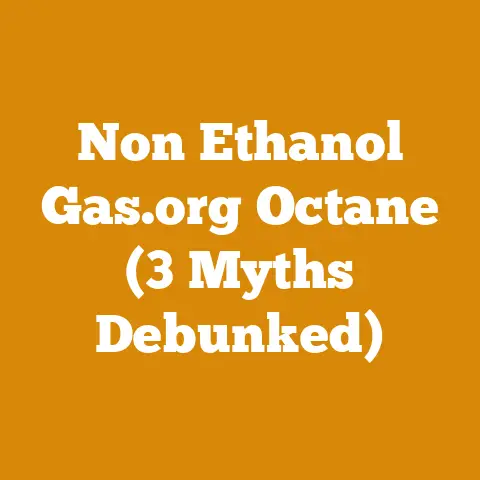How Long Will Ethanol-Free Gas Last (3 Storage Secrets)
When I first got my hands on a high-performance chainsaw years ago, I realized the importance of using the right kind of fuel. One expert tip I learned was using ethanol-free gas for storage. Why? Because it can last significantly longer than regular gasoline, which tends to degrade quickly due to ethanol content. Let me share with you some secrets and insights on how long ethanol-free gas can last and how you can extend its shelf life.
Why Ethanol-Free Gas?
Ethanol-free gas is a favorite among those who use small engines, like chainsaws and lawnmowers. Ethanol tends to attract moisture, leading to corrosion and other engine issues. Using ethanol-free gas minimizes these risks, making it ideal for storage and preserving engine life.
The Science Behind Ethanol-Free Gas
Ethanol, a type of alcohol added to gasoline, is used to oxygenate the fuel and reduce emissions. However, it has a downside. Ethanol absorbs water from the air, leading to phase separation in fuel mixtures. This can cause serious problems in small engines, which are sensitive to water contamination.
In contrast, ethanol-free gasoline doesn’t have this tendency, making it a stable option for long-term storage. By choosing ethanol-free gas, you’re effectively reducing the chances of water accumulation in your fuel system, which can cause everything from poor performance to engine damage.
Storage Secret #1: Use a Stabilizer
One of the best ways to extend the life of your ethanol-free gas is by adding a fuel stabilizer. I always keep a bottle handy in my garage.
Steps to Add a Stabilizer:
- Purchase a Quality Stabilizer: Look for one compatible with ethanol-free gas.
- Measure the Correct Amount: Follow the instructions on the bottle for the right ratio.
- Add to Gasoline: Pour the stabilizer into your gas can before filling it with ethanol-free gas.
- Mix Well: Shake or stir the container to ensure even distribution.
Safety Tip: Handle stabilizers with care. Wear gloves and avoid inhaling fumes.
Adding a stabilizer can extend the shelf life of your gas up to two years. It’s an easy investment that pays off in engine performance.
Personal Experience with Stabilizers
I remember a time when I forgot to add a stabilizer to a batch of stored gasoline. Months later, when I tried using it in my chainsaw, it led to rough idling and starting issues. Since then, I’ve made it a point to never skip this step.
Detailed Benefits of Stabilizers
- Prevents Oxidation: Stabilizers slow down the oxidation process that turns fuel stale.
- Maintains Combustion Quality: Keeps the fuel’s volatility intact for efficient engine firing.
- Reduces Gum and Varnish Buildup: Stabilizers help maintain clean fuel systems by preventing sticky residues.
Comparing Stabilizers
There are many brands available, and choosing the right one can be tricky. Some popular options include STA-BIL, Sea Foam, and Lucas Oil Stabilizer. Each has unique properties, but they all serve the purpose of prolonging fuel life.
Tip: Always read product reviews and consult with fellow users to find the best stabilizer for your needs.
Storage Secret #2: Proper Storage Containers
The container you use plays a crucial role in preserving your ethanol-free gas. Here’s what I’ve learned from experience:
Choosing the Right Container:
- Material Matters: Opt for metal or high-density polyethylene plastic containers.
- Seal It Tight: Ensure the lid seals completely to prevent air and moisture from getting in.
- Size Appropriately: Use containers that match the amount of gas you’re storing to minimize air space.
Warning: Never store gasoline in non-approved containers as it poses safety risks.
My Container Choices Over the Years
From my early days of storing fuel in old soda bottles (big mistake!) to investing in purpose-built gas cans, I’ve seen firsthand how container choice affects fuel quality.
Breakdown of Container Types
- Plastic Containers:
- Lightweight and generally more affordable.
- Susceptible to static electricity—must be grounded when filling.
- Metal Containers:
- Durable and less permeable to vapor loss.
- Heavier and prone to rust if not maintained properly.
- Specialized Storage Tanks:
- Best for large quantities.
- Require more maintenance but offer superior protection against contaminants.
Maintenance Tips for Containers
- Regularly inspect for cracks or leaks.
- Clean thoroughly before refilling.
- Ensure proper labeling to avoid mix-ups.
Storage Secret #3: Store in a Cool, Dry Place
Environment affects gasoline longevity. Let me share why location is key:
Ideal Storage Conditions:
- Temperature Control: Keep gas in a place where temperatures remain stable, ideally between 50-70°F.
- Avoid Sunlight: Direct sunlight can cause chemical reactions, degrading fuel quality.
- Humidity Control: A dry area prevents moisture-related issues.
Tip: A garage or shed often works well, but ensure good ventilation.
My Storage Setup
I converted part of my garage into a dedicated storage area with temperature control and humidity management systems. This might seem excessive, but it ensures my equipment runs smoothly year-round.
Creating the Perfect Storage Environment
- Temperature Regulation:
- Use fans or heaters as needed to maintain consistent temperatures.
- Avoid extreme temperature fluctuations.
- Humidity Management:
- Install a dehumidifier if necessary.
- Keep stored fuel off damp floors using pallets or shelving.
- Ventilation:
- Ensure airflow to prevent vapor buildup.
- Consider exhaust fans if storing large quantities.
Common Questions & Concerns
How Can I Tell if Gasoline Has Gone Bad?
Look for changes in color or smell. Bad gas may appear darker and have a sour odor.
What Happens if I Use Old Gas?
Using degraded fuel can lead to poor engine performance or damage. It may result in hard starts or stalling.
Troubleshooting Tips:
- Engine Hesitation: If your chainsaw hesitates, check the fuel condition first.
- Check Filters: Ensure fuel filters are clean and free of debris.
- Regular Maintenance: Keep up with routine checks and cleaning for optimal performance.
Additional Concerns
What if I Accidentally Use Ethanol-Blended Gas?
If you find yourself using ethanol-blended gas by accident, don’t panic. For short-term use, it won’t necessarily harm your equipment, but avoid long-term storage without adding a stabilizer specifically designed for ethanol blends.
Tip: Drain and refill with ethanol-free gas as soon as possible to prevent potential issues.
Mixing Fuels: What’s Safe?
Mixing old and new gasoline is generally discouraged as it may lead to inconsistent performance. However, if you’re in a pinch, blending small amounts shouldn’t cause major issues—just be sure to use it quickly and monitor engine behavior closely.
Important Reminders & Next Steps
The right approach to storing ethanol-free gas can save you headaches down the road. Always prioritize safety and proper storage techniques. Keep stabilizers stocked, choose appropriate containers, and find the best storage spot in your home.
Next Steps:
- Review your current storage practices.
- Invest in quality stabilizers and containers.
- Regularly check stored gasoline condition.
FAQ Section
Q1: How long does ethanol-free gas last without a stabilizer?
A: Typically, it lasts about 3-6 months without a stabilizer.
Q2: Can I mix old and new gasoline?
A: It’s best to avoid mixing; use fresh gas to ensure performance.
Q3: Is there a risk of explosion with stored gasoline?
A: Yes, if improperly stored. Always use approved containers and store safely.
Q4: Are stabilizers necessary even for short-term storage?
A: While not strictly necessary for short-term storage (up to 30 days), stabilizers provide peace of mind by protecting against potential degradation over time.
These secrets have served me well over the years, ensuring my chainsaws run smoothly when I need them most. Whether you’re a seasoned pro or just getting started, these tips will help you make the most of your ethanol-free fuel.






